Digital marketing is a multi-faceted process. Not only do you need a diverse set of sales skills to successfully promote your brand, but you also need to know when to use them. Applying this nuance to ad copy, should you use short copy or long copy can be a particularly daunting challenge.
Fortunately, understanding when to use short and long copy to get the greatest return on your investment doesn’t have to be complicated. By reviewing the strengths of each and tailoring the length of your ad copy to your goals, you can maximize the effectiveness of your marketing campaigns.
In this article, we’ll cover the differences between short and long copy. Then, we’ll show you how to decide which ad copy approach makes the most sense in any given situation. Finally, we’ll wrap up with some practical tips for creating strong ad copy of any length.
Let’s get started!
The Pros and Cons of Short vs. Long Copy (And When to Use Each) – By understanding the difference between short and long copy, you can deploy each with confidence and make the most of your page space. Click To TweetThe Differences Between Short and Long Copy
It might not seem like a big deal, but there are some important differences between the roles short and long copy play in digital marketing. Understanding what makes each unique is the first step towards choosing the right length for your campaigns, which can, in turn, help improve your results.
Let’s start with short copy.
It encompasses marketing material that’s less than 1,000 words. Its purpose is to pique interest, encourage action, or communicate a simple concept.
Short copy can be very diverse, ranging from taglines to mail ads. Here’s an example from the oral hygiene company Quip:
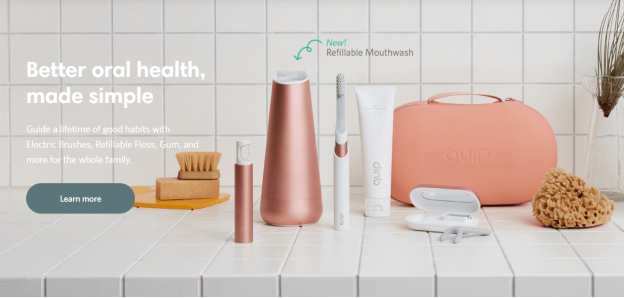
The writing is concise and to the point. Brief ads tend to be memorable. Additionally, the limited message can usually be understood with little effort on behalf of the reader. It’s scannable.
However, there are some drawbacks to using short copy. Getting to the core of your message with a limited word count can be tricky. You might also find that more nuanced concepts aren’t adequately described in under 1,000 words. For more complex or expensive products or services, you will need more copy to overcome objections.
Long copy – typically exceeding 1,000 words – is usually meant to involve the reader for a significant amount of time. Blog posts, full-page ads, and sales letters are a few examples of this format. Here’s an example of long copy from Quip:
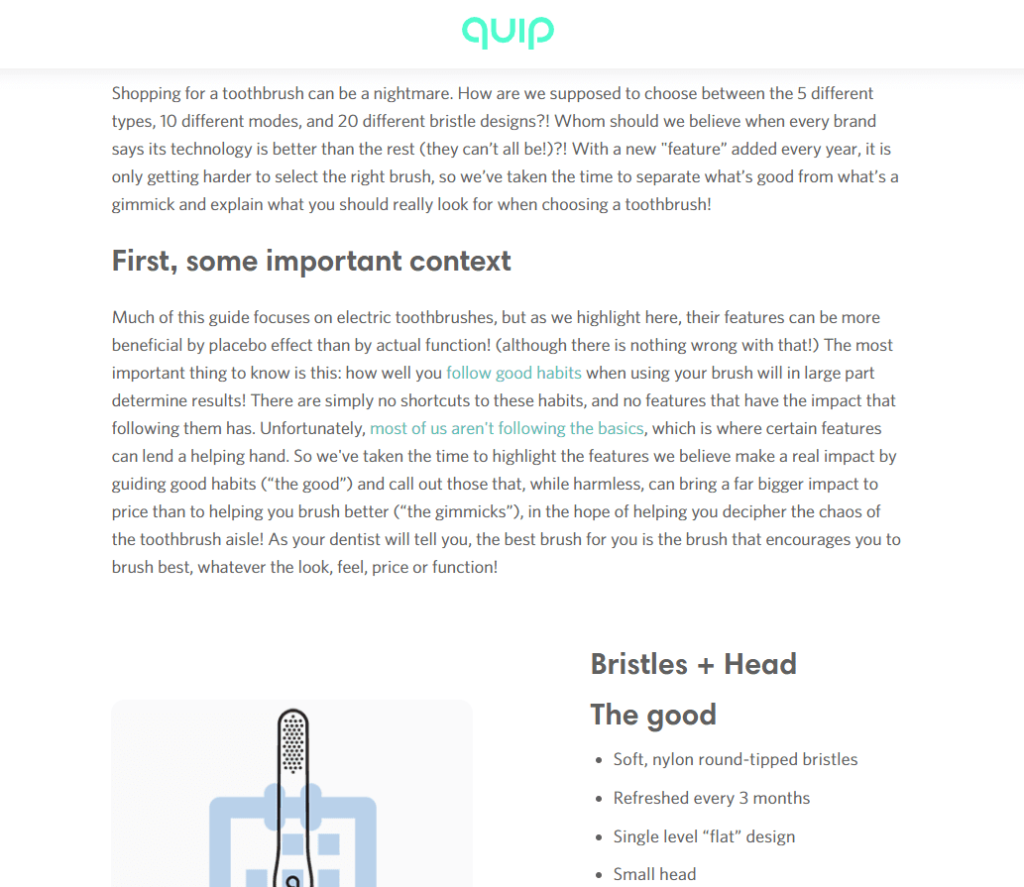
Greater length offers unique benefits. Fewer limitations mean the copy can include varied formatting. Long copy helps you nurture a closer bond with your readers and lets you develop a more comprehensive pitch. For more on this, read our post on landing page best practices.
Nonetheless, you might risk losing your audience’s attention with long copy. Formatting, images and a deep understanding of the customer journey will mitigate this risk.
Readers also typically require a base-level investment in your brand to be interested in the first place. Do they know you? Is it clear that you have a solution for their problem?
If you’re looking to combat these drawbacks, try to make your page layout approachable and the writing ‘skimmable’ with clear and frequent headings.
How to Decide When to Use Short vs. Long Copy (3 Key Considerations)
Short and long copy are both valuable resources in your marketing toolbox. Each approach will be most effective when used in suitable situations. To maximize your marketing effectiveness, keep these considerations in mind to determine the ideal length for your copy.
1. Assess the Customer Position in the Digital Marketing Funnel
A digital marketing funnel can be a useful way to gauge what length of writing your campaign needs. The funnel represents an individual’s place in the sales process – consumers know your brand at the top, engage in the middle, and purchase at the bottom.
Each stage requires a different approach. By establishing which level your target audience is currently in, you can tailor your writing to encourage whatever action you feel will bring customers closer to the bottom.
Pro Tip
In the end, if the reader isn’t interested in your offer it doesn’t matter whether the ad copy is long or short. If they are interested, then give them the information they need to make a decision.
If you’re targeting customers at the top of the funnel, you might want to consider using short ad copy. The goal at this stage is to spread the word about your brand and establish credibility. Use shorter copy in ads to draw prospects into more extensive articles.
These longer articles also support attracting interested prospects using SEO. For example, let’s say you own a business that sells running shoes. By producing more extensive writing about topics such as running techniques and improving performance, you’ll attract people who are searching for that information. Consuming your articles will introduce readers to your products without a hard sales pitch. This is a microtransaction that builds trust between the brand and the consumer.
Short copy also works better towards the bottom of the funnel. The truncated format lets you urge readers in the direction of a purchase. In many scenarios, a well-placed bit of ad copy can clinch a conversion.
For instance, in our running shoe business scenario, you might send potential customers an email featuring short copy inviting them to buy the shoes they just read about or use short copy email to encourage them to complete the purchase that’s in their cart. A concise approach works well here because your audience is already interested in the purchase – you’re just providing an actionable reminder.
The right length is situation-dependent.
2. Consider the Relative Novelty of the Concept
When you’re marketing a product, consider how likely your target audience is to be familiar with it. Newer offers may require some explanation. On the other hand, established products usually need little introduction.
If you’re marketing something that you think merits some discussion, consider using long copy. Whether it’s a concept your audience has never heard of or just a new direction for your brand, a more extensive format can equip you with the space you need to convey essential information.
The same goes for familiar concepts with subtle twists you’d like to highlight. Wendy’s recently used long copy to dig into the details of a new sandwich:

While it’s unlikely that chicken sandwiches are new to consumers, Wendy’s flavor addition might be unexpected. This press release helps to advertise a taste that not everyone might expect. It also works to generate some buzz.
However, you might not need many words for simpler products. This can be especially true for items your audience is already very comfortable with. This is well illustrated by another marketing effort by Wendy’s, this time for classic french fries:
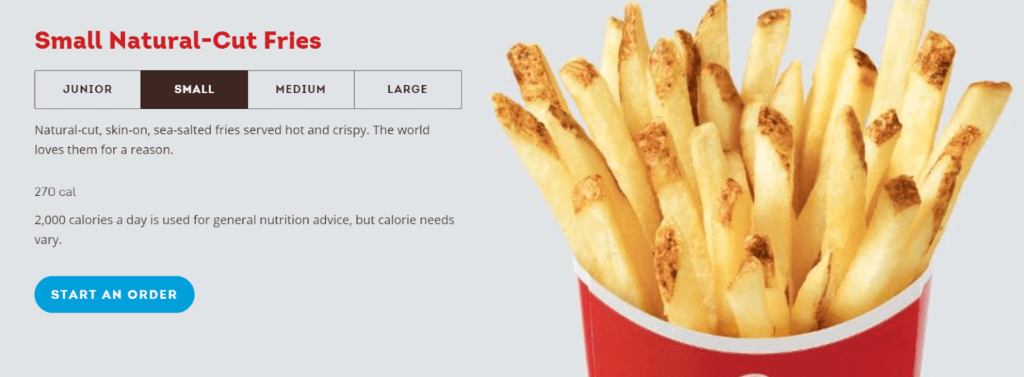
Given the popularity of french fries, Wendy’s opted to use short copy. The fast-food company likely reasoned that with little to introduce, the product could be effectively advertised with two short sentences.
Occasionally, the distinction can be more subtle. If you’re offering a product with a new yet simple addition, such as a more powerful electric toothbrush, the choice of length might be less clear.
In situations like this, consider erring on the side of simplicity and clarity. Adding unnecessary content just to reach a certain word count might muddle your message and get in the way of sales.
3. Write for the Ideal Customer Outcome
Before you decide on a length, it might be helpful to consider what your ultimate goal is for your campaign. Try asking yourself what your customer will ideally do after reading a perfect version of your content. You can then write with this clear outcome in mind.
Some goals are non-specific actions. Examples include building an understanding of your brand among your audience, teaching readers about what your service entails, or fostering trust in your products.
Objectives that lack distinct benchmarks will likely look different for each customer. To that end, you might find that long copy is better for such scenarios as it provides more latitude to get the job done.
By contrast, you might be looking for more concrete progress. Maybe your goal is to attract attention, obtain a customer’s email, or entice visitors to make purchases. In more tangible cases like these, it’s often beneficial to use short ad copy.
Longer-form content can occasionally obscure the action you’re encouraging the audience to take. As such, a straightforward presentation of your point might be the best option. A truncated format also delivers your actionable information quicker.
It’s advisable to consider the optimal length for your copy in the early stages of planning a campaign. This can give you a big-picture view of the content and the end goal. Determining your long-term plan can ensure you’re using both kinds of ad copy in line with their strengths.
Knowing the metrics you’re using to measure your success can be instrumental in guiding your approach. You can also use a clear plan to focus your efforts on your top sales priorities.
Advice for Developing Ad Copy for Digital Marketing
When it comes to writing, a few pieces of advice typically apply to content of all lengths. However, the tips below are suggested guidelines only. We recommend testing out different types of copy to see what works best for your audience.
One element to consider when writing copy is personality. Developing a specific tone can give your customers a frame of reference for your brand’s values. A distinct character can also help make shorter advertisements more memorable, as ModCloth does with its sunny voice:
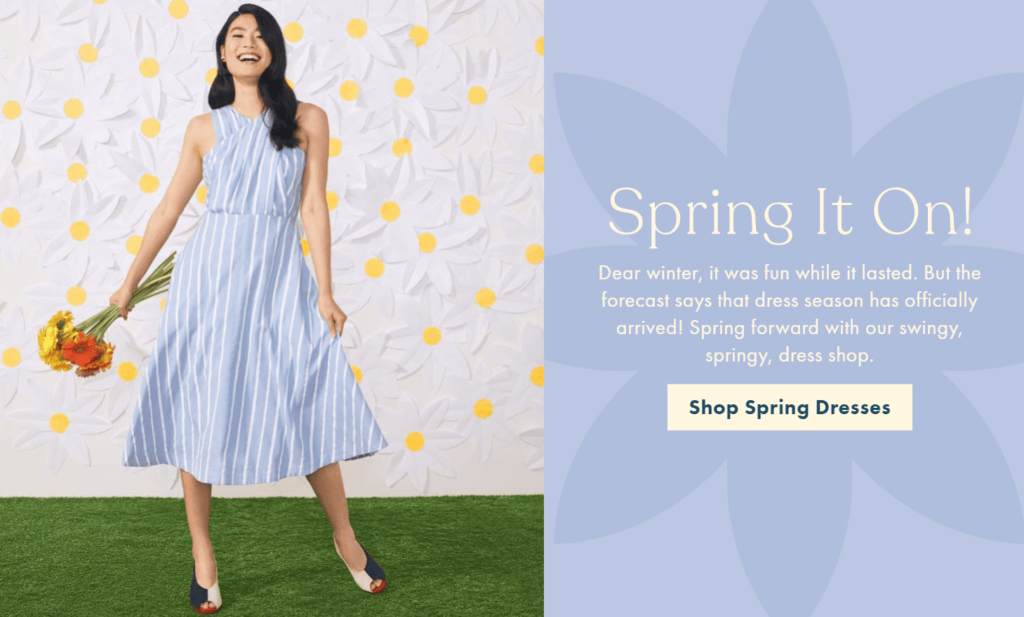
Another strategy you might find helpful is providing your customers with a clear visualization of what they can gain from your product. For example, if you’re promoting a hand mixer, you might highlight how much baking time customers will save by using it.
Longer formats let you go into depth about how the product will deliver on its promise. Stitch Fix does this subtly, demonstrating scenarios in which consumers might want more options in their closets:
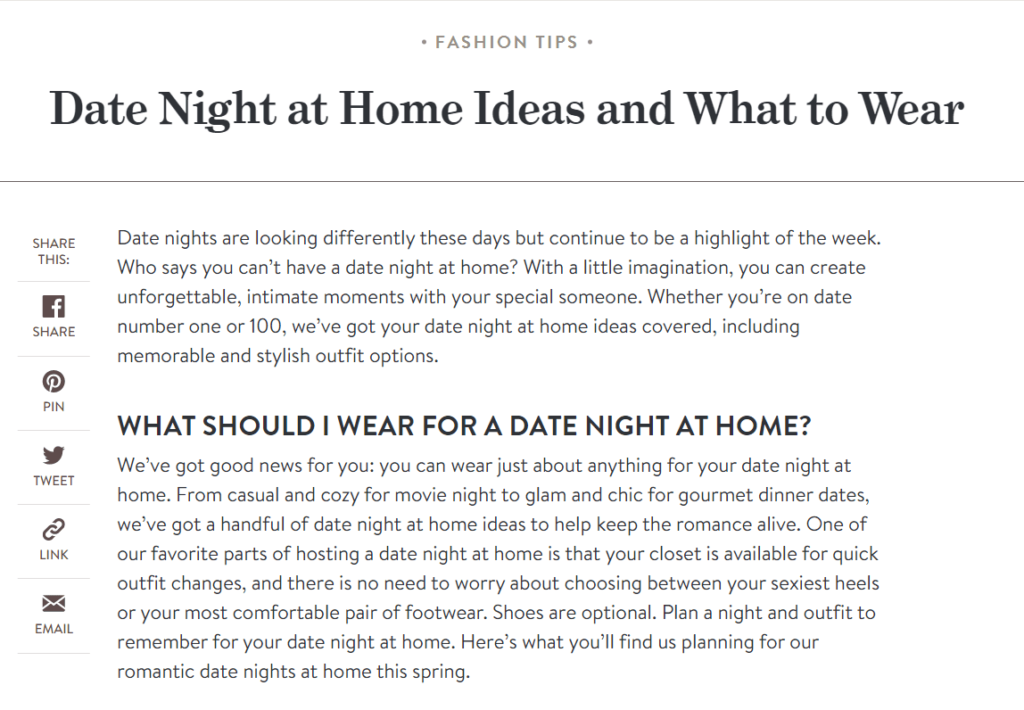
Finally, try to include a clear Call To Action (CTA) in all of your writing. This can take on many forms. It might look like an invitation to visit your website or to purchase your product.
A CTA is an effective way to encourage engagement and keep your brand at the top of readers minds, like the wine pairing service Bright Cellars highlights at the end of a recent blog post:

Providing clear direction can make a big difference. If you want to optimize your CTAs, try sticking to one action that’s easy for your audience to follow through on.
Conclusion
Digital marketing can feel like a bit of a puzzle sometimes. Finding the solution requires you to be creative, resourceful, and familiar with the strategies at your disposal. By understanding the difference between short and long ad copy, you can confidently deploy each and make the most of your digital advertising.
In this article, we covered three tips to help you decide when to use short ad copy vs. long ad copy:
- Consult the digital marketing funnel to determine where your customers currently are in the buying process.
- Gauge how novel the concept is and how much explanation it requires.
- Consider the optimal action your readers will take after viewing your copy.
Do you have any questions about the differences between short and long copy? Use this link to book a time to chat.
Author: James Hipkin
Since 2010, James Hipkin has built his clients’ businesses with digital marketing. Today, James is passionate about websites and helping the rest of us understand online marketing. His customers value his jargon-free, common-sense approach. “James explains the ins and outs of digital marketing in ways that make sense.”
Use this link to book a meeting time with James.

